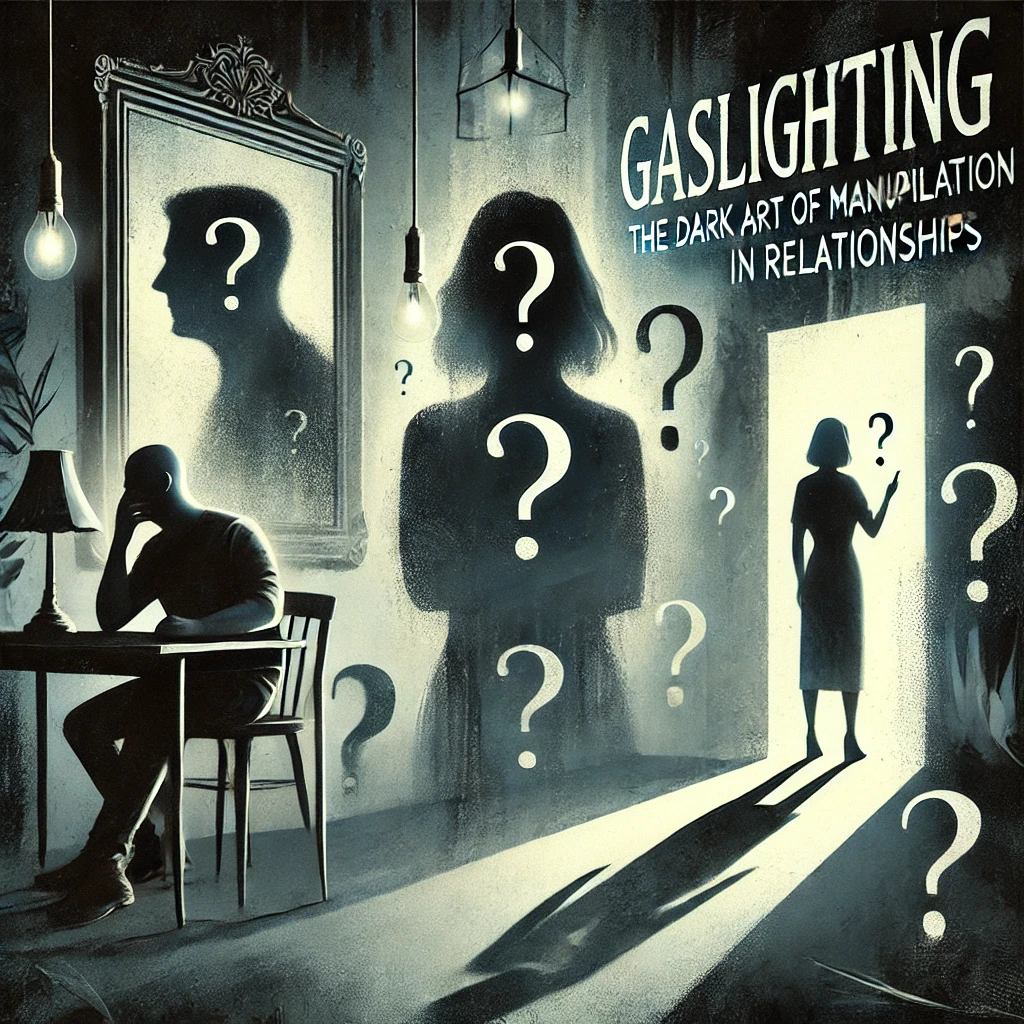Let’s be honest—every relationship has its moments of disagreement, misunderstanding, or emotional friction. But when those moments are subtly twisted to make one person doubt their perception of reality, that’s when we enter the territory of gaslighting. It’s a psychological manipulation tactic that’s more common than we’d like to admit, and it’s one of the most powerful—yet dangerous—tools in the realm of dark influence.
In “Mastering Him: The Secret Art of Gentle Control in Relationships”, Chapter 8 dives deep into gaslighting, exposing how this controversial tactic can be used (ethically, if that’s even possible) to guide your partner without them realizing it. Gaslighting, when understood, can shift relationship dynamics in ways that make one person feel as though they’re constantly questioning their memory, sanity, or understanding of events. Sounds harsh? It can be. But like any tool of influence, gaslighting is as much about intention as it is about execution.
So, how does gaslighting work? How can something so subtle be so powerful in a relationship? Let’s take a deep dive into this dark influence tactic, exploring how it operates, why it’s so effective, and what the consequences are when it’s misused. We’ll also discuss whether there’s ever an ethical way to use this method and provide real-life examples of how gaslighting might show up in everyday interactions.
What Is Gaslighting?
Gaslighting is a psychological tactic used to make someone question their perception of reality. It’s a form of subtle manipulation where the gaslighter undermines their partner’s memories, emotions, or experiences, causing them to doubt their understanding of situations. Over time, the person being gaslit may feel confused, insecure, or even unstable in their own thoughts and feelings.
The term comes from the 1944 movie Gaslight, where a husband manipulates his wife into believing she’s going insane by dimming the gas lights in their home and denying it when she notices. This form of manipulation has since become synonymous with controlling someone by altering their reality, often to gain power or avoid accountability.
Why Does Gaslighting Work in Relationships?
Gaslighting works because it taps into the trust and emotional vulnerability that exist in relationships. When you love and care for someone, you’re more likely to believe what they say—even if it contradicts your own perception of events. Over time, this can create a power imbalance, where one person holds control over the other’s sense of reality.
It’s a powerful tool of influence because it’s often gradual and hard to detect. Gaslighting isn’t about loud arguments or obvious manipulation. It’s subtle, slow, and insidious, making the person being gaslit doubt themselves more and more as time goes on.
Real-Life Examples of Gaslighting in Relationships
Let’s explore some real-life examples of how gaslighting might show up in everyday interactions. These scenarios will help you understand how this tactic can be used to subtly shift the power dynamic in a relationship—often without the person being gaslit realizing what’s happening.
Example 1: Denying Past Conversations
Let’s say you and your partner had a conversation about planning a trip. You both agreed on the destination and dates, but when the time comes to book the trip, your partner denies ever having that conversation.
Gaslighting in Action:
Your partner might say, “I don’t remember us ever agreeing to that. Are you sure you didn’t just think we talked about it? You’ve been really stressed lately, and sometimes you mix things up.” This subtle denial of the past conversation makes you question your own memory and feel uncertain.
Why It Works:
By denying the conversation and planting the idea that you’re misremembering, your partner makes you doubt your own recollection of events. You may feel less confident in bringing up the conversation again, allowing them to control the outcome.
Example 2: Undermining Emotions
You bring up something that upset you—a comment or behavior that hurt your feelings—but instead of acknowledging it, your partner tells you that you’re overreacting or being too sensitive.
Gaslighting in Action:
When you express your emotions, your partner responds with, “You’re blowing this way out of proportion. You always overreact to things like this. It wasn’t a big deal, and I don’t know why you’re making it one now.” This response makes you question whether your feelings are valid, leaving you feeling guilty or ashamed for bringing it up.
Why It Works:
Gaslighting invalidates your emotions, making you feel as though you’re wrong for feeling the way you do. Over time, this can lead you to suppress your feelings, giving your partner more control over the emotional dynamic of the relationship.
Example 3: Rewriting History
You and your partner had an argument last week, and you clearly remember the key points of the disagreement. But when you try to revisit the topic, your partner completely changes the narrative, claiming that things happened differently.
Gaslighting in Action:
Your partner might say, “That’s not how it happened at all. You were the one who started the argument, and I was just defending myself. I think you’re remembering it wrong.” This revision of history makes you doubt your own recollection of the argument, leaving you confused about what really took place.
Why It Works:
By rewriting the past, your partner takes control of the narrative, making you question your own memory. This can make you feel uncertain about addressing issues in the future, allowing them to dictate how conflicts are resolved.
The Long-Term Impact of Gaslighting
Over time, gaslighting can have serious consequences for the person being manipulated. It can lead to feelings of anxiety, self-doubt, confusion, and even depression. The person being gaslit may start to question their own sanity, making them more dependent on the gaslighter for validation and reality-checking.
Gaslighting also creates a power imbalance in the relationship, where the gaslighter holds more control over decision-making, emotions, and perceptions. This dynamic can lead to emotional abuse if left unchecked, as the gaslighter continually undermines their partner’s sense of reality.
Is There an Ethical Way to Use Gaslighting?
Here’s where things get controversial. Chapter 8 of “Mastering Him” asks a bold question: Is there an ethical way to use gaslighting? While the tactic itself is often seen as abusive, the book explores how subtle elements of gaslighting—such as gently reframing situations or shifting perspectives—can be used in a way that’s not harmful, as long as both partners ultimately benefit.
For example, if your partner is catastrophizing a situation—believing that everything is going wrong when only a small issue has occurred—reframing the narrative by saying, “It seems like you’re overwhelmed right now. I think you’re seeing this as worse than it really is. Let’s take a step back and look at the facts,” can be a way to help them regain perspective.
The key here is intent. Are you using gaslighting to control and manipulate your partner, or are you reframing situations to help them gain clarity? It’s a fine line, and one that should be approached with caution.
How to Recognize Gaslighting in Your Relationship
If you’re concerned that gaslighting may be present in your relationship, here are a few signs to watch out for:
- Constantly doubting yourself: You find yourself frequently questioning your memory or perception of events.
- Feeling overly sensitive: Your partner dismisses your emotions, making you feel like you’re overreacting.
- Rewriting of past events: Your partner often denies things that happened or changes the details of past conversations.
- Feeling confused or off-balance: You feel like you’re always unsure of what’s real or true in the relationship.
If these signs resonate with you, it may be time to have an open and honest conversation with your partner—or seek support from a therapist.
Q&A:
- What is gaslighting, and how does it work in relationships?
Gaslighting is a form of psychological manipulation where one partner makes the other doubt their memory, perception, or sanity. It’s a subtle tactic that can erode trust in one’s reality over time. - What are common signs of gaslighting in a relationship?
Signs include frequently doubting your memory, feeling overly sensitive, and having your partner deny past events or rewrite history. It often leaves you feeling confused and questioning your perception. - Why do people use gaslighting as a tactic in relationships?
People use gaslighting to gain control, avoid accountability, or shift power dynamics. By making their partner doubt themselves, the gaslighter maintains an advantage in decision-making and emotional influence. - What are some real-life examples of gaslighting behavior?
Examples include denying past conversations, undermining emotions by calling you “too sensitive,” or rewriting events to make themselves look less at fault. These actions slowly make you doubt your reality. - What are the long-term effects of gaslighting on a person?
Long-term effects can include anxiety, depression, low self-esteem, self-doubt, and increased dependence on the gaslighter for validation, which can lead to an unhealthy power imbalance in the relationship. - How do you respond to gaslighting in a relationship?
Recognize the manipulation, trust your perceptions, and set boundaries by openly addressing the behavior. Seeking outside support or therapy can help you regain confidence in your perspective. - Is gaslighting considered emotional abuse?
Yes, gaslighting is a form of emotional abuse. It manipulates a person’s perception, causing them to doubt their sense of reality, which can lead to feelings of confusion, insecurity, and emotional dependency. - Can gaslighting ever be used ethically in a relationship?
While controversial, some believe elements like gentle reframing or helping a partner see a situation more clearly might be ethical. However, intention is key—using it to control is harmful, while aiming to aid perspective can be constructive. - What’s the difference between gaslighting and regular disagreements?
In regular disagreements, both perspectives are acknowledged. Gaslighting, however, involves denying the other’s perception outright, often rewriting events to create doubt and maintain control. - How can I tell if I’m gaslighting my partner without realizing it?
Reflect on whether you frequently dismiss your partner’s feelings, deny past conversations, or rewrite events. Honest self-assessment and open communication can help ensure healthy interactions.
Ready to Master the Subtle Art of Influence in Your Relationship?
If you’re ready to dive deeper into the psychological dynamics of relationships and learn how to use powerful techniques like gaslighting responsibly, “Mastering Him: The Secret Art of Gentle Control in Relationships” is the book for you. In Chapter 8, you’ll learn how to navigate the controversial waters of influence, from reframing conversations to managing emotions, all while maintaining ethical control.
This isn’t just about tactics—it’s about understanding the deeper layers of influence that exist in every relationship. Whether you’re looking to improve communication, guide your partner’s decisions, or simply understand the dynamics of power, this book has the answers.
Get your copy today and start mastering the art of gentle control in your relationship—because understanding influence is the first step toward creating lasting harmony and connection.
Read more about the book: https://developmentpill.com/mastering-him-the-secret-art-of-gentle-control-in-relationships-a-guide-to-influence-hell-never-see-coming/
Book Link: https://www.amazon.com/dp/B0DKKGLZQ9
Book Link UK: https://www.amazon.co.uk/dp/B0DKKGLZQ9
You can find book Links for other regions in this post page: https://developmentpill.com/mastering-him-the-secret-art-of-gentle-control-in-relationships-a-guide-to-influence-hell-never-see-coming/



